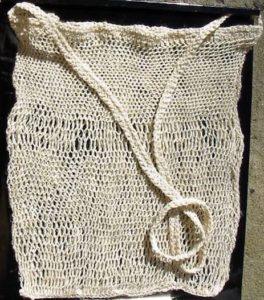Hemp Tales
by Stephenie Gaustad
Hemp is an ancient central Asian fiber, source for protection from weather: rain or shine. For
thousands of years, it has been twisted into “cordage” for ropes and canvas and spun into fine
yarn for clothing weight fabrics.
This cellulose fiber is highly absorbent, strong, and naturally “whitish” with a tinge of yellow, green or brown.
The plant is dioecious, (two sexes) grown in close proximity, causing the male plants to shoot
up to six or seven feet tall. The female plants are shorter: 4-5 feet. All of this depends on
richness of the soil, temp, sunlight duration and water availability. Both sexes yield usable
fiber with the male plants yielding the longest possible fibers, should you need such length.
The fiber resides just below the plants “skin” in the water/nutrient transfer cells running from
the roots to the leafy crown. 100 pounds of pulled hemp can yield 30-45 pounds of retted, dry
stalks or 10-15 lbs of clean hemp fiber. This is because much of the hemp plant is a “foam
core”.
There can be a lot of waste in hemp processing. When industrially harvested, the staple that
runs from roots to a leafy crown, is crushed and broken into 1-2 inch staple length, making it
available to standard cotton spinning technology. But there is another way to release the long fibers.
Stems can be retted and side branches removed, the epithelial “skin” and food/water cells just beneath it can be stripped off as long ribbons. The ”ribbons” can be further processed by hackling, or simply splitting the ribbon into finer and finer widths.
Hemps’ utility, beauty and strength has been difficult for the handweaver/spinner to access
and use. There is a new trend which makes hemp more accessible by removing local legal
barriers to growing, harvesting and processing beautiful hemp. Hemp! Hemp! Hooray!
For next page click here